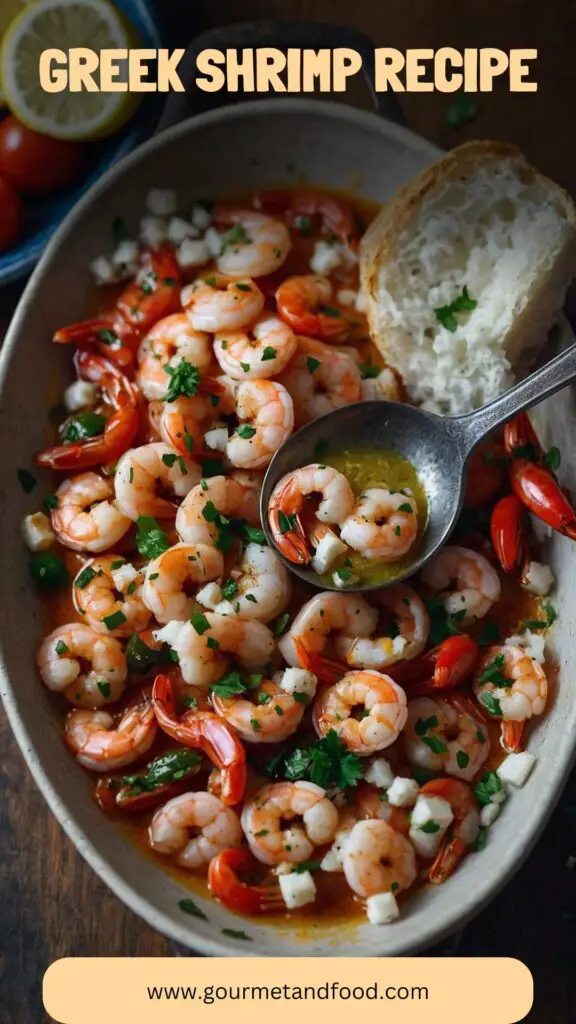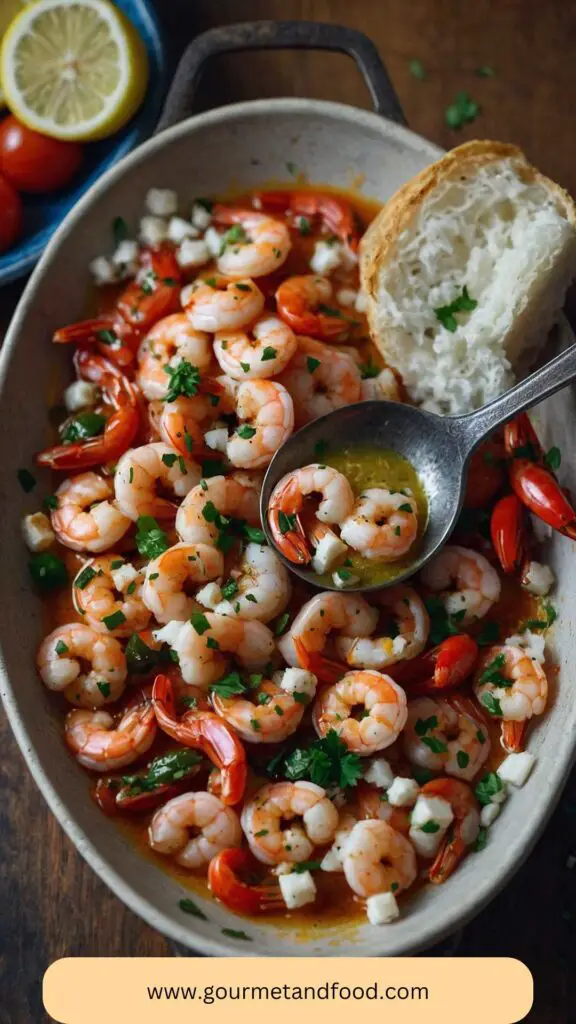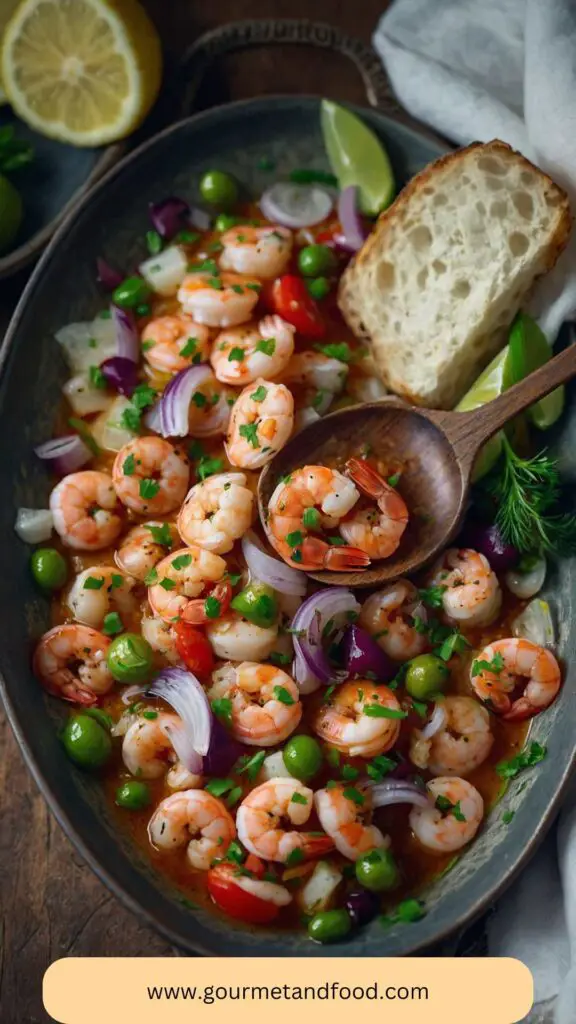Before diving into the culinary adventure that is Greek shrimp, it’s worthwhile to explore what can elevate the experience even further. Pair this delightful dish with fresh Greek salad, complete with crunchy cucumbers and juicy tomatoes.
A bowl of rice or orzo can serve as a comforting base that soaks up the delectable flavors. Serve alongside some warm, crusty bread to mop up the leftover sauce. To finish it off, a glass of chilled white wine, perhaps a crisp Sauvignon Blanc or a smooth Pinot Grigio, would complement the meal splendidly. Now, let’s get into this mouthwatering dish!

The sun-drenched shores of Greece inspire many culinary creations, and one of the jewels in its crown is Greek shrimp. This dish combines fresh shrimp with vibrant ingredients, bursting with flavors that take you straight to the Mediterranean. Imagine sinking your fork into juicy shrimp smothered in a zesty sauce of tomatoes, olives, and feta cheese, all while listening to the waves crashing in the distance. What one might initially overlook is how simple these ingredients come together to produce a meal that feels anything but basic. This recipe is an invitation to enjoy a tasty, healthy feast that’s a breeze to prepare.
You Might Also Like These Recipes!
What is Greek Shrimp?
Greek shrimp, or “garides saganaki,” is a traditional Greek dish featuring shrimp cooked with tomatoes, feta cheese, and a medley of spices. The combination results in a warm, comforting meal that is rich in flavor and nutrients. Shrimp cooked in this style often incorporates olives and fresh herbs, reflecting the diverse agriculture of the Mediterranean. It captures the essence of coastal life and offers a delicious peek into Greek culinary traditions.
Why This Recipe Works
This recipe works exceptionally well for several reasons. First, the fusion of flavors—savory shrimp, tart tomatoes, salty feta, and briny olives—creates a taste profile that dances on the palate. Each ingredient contributes its uniqueness, elevating the dish. Moreover, it illustrates that cooking doesn’t need to be complicated to be satisfying. The simple steps make it perfect for weeknight dinners or when hosting friends for an informal gathering.
What You’ll Need to Make This Dish
Gathering the right ingredients sets the stage for a remarkable meal. Here’s what you need:
- 1 tablespoon chopped fresh oregano (or 1 teaspoon dried)
- 3 ounces crumbled feta cheese (preferably sheep’s milk feta)
- ½ teaspoon freshly ground black pepper
- ¼ cup fresh mint leaves, torn (or substitute with fresh parsley or basil)
- 2½ cups ripe tomatoes, chopped
- ¼ cup Kalamata olives, sliced
- ½ teaspoon crushed red chili flakes
- ½ teaspoon fine sea salt
- 1¼ to 1½ pounds large raw jumbo shrimp, peeled and deveined
- Zest and juice of 1 lemon
- 1 cup finely chopped yellow onion
- 4 tablespoons high-quality extra virgin olive oil
- 6 garlic cloves, coarsely chopped
How to Make Greek Shrimp
This dish is not only rewarding but also surprisingly straightforward. Let’s walk through the steps necessary to create this Mediterranean delight.
Step 1: Prepare the Ingredients
Begin by gathering all your ingredients. Chop the tomatoes, onion, and garlic, and measure out the olives and feta. Setting everything out ensures a smooth cooking experience.
Step 2: Sauté the Aromatics
In a large skillet, heat the olive oil over medium heat. Add the chopped onions and chopped garlic. Sauté them until the onions become translucent and fragrant, about 3-5 minutes. This initial step creates a flavorful base for the dish.
Step 3: Add Tomatoes and Spices
Once the onion and garlic are fragrant, throw in the chopped tomatoes, oregano, salt, pepper, and chili flakes. Stir occasionally, allowing the mixture to simmer and the tomatoes to break down, creating a chunky sauce. You’re aiming for about 10-15 minutes of cooking.
Step 4: Introduce the Shrimp
After the tomatoes have melded nicely, it’s time to add the shrimp. Gently fold them into the sauce. Cook for an additional 5-7 minutes until the shrimp turns pink and opaque, indicating they are cooked through.
Step 5: Finish with Feta and Herbs
Now, take the skillet off the heat and sprinkle the crumbled feta, mint leaves, and lemon zest over the top. Remember, you want that feta to slightly melt and blend with the sauce.
Step 6: Serve and Enjoy
With the dish ready, it’s time to serve. We all know presentation counts, so pile the Greek shrimp onto a serving platter and garnish with extra herbs if desired. Enjoy it with your chosen side and a big smile.

Tips for Perfect Greek Shrimp
- Use Fresh Ingredients: Fresh shrimp and ripe tomatoes make a huge difference in flavor. Whenever possible, buy local seafood.
- Adjust the Heat: If you like things spicy, increase the amount of crushed red pepper. If not, play it safe with just a sprinkle.
- Don’t Overcook: Keep an eye on the shrimp. They cook quickly, and overcooking can lead to rubbery texture.
- Experiment with Herbs: Feel free to mix it up. Basil, parsley, or dill can give your dish a unique twist.
- Add a Twist with Spinach: Toss in some fresh spinach to the sauce during cooking for extra nutrients and color.
How to Store Leftovers?
Leftover Greek shrimp can last about 3 days in the refrigerator when stored in an airtight container. It’s best enjoyed fresh, but if you have leftovers, the dish reheats nicely. Just make sure to warm it on low on the stovetop to prevent the shrimp from becoming tough.
Nutrition Information
Greek shrimp is not just a flavorful dish but also a healthy one. A typical serving offers approximately:
It’s a great way to get a healthy dose of protein, vitamins, and minerals, all while enjoying delicious flavors.

How Would I Recommend Serving Greek Shrimp?
- With a Greek Salad: A refreshing complement, this salad, filled with cucumbers, tomatoes, red onion, and olives, balances the dish perfectly.
- Over Rice or Quinoa: This hearty option absorbs the sauce wonderfully, making each bite rich in flavor.
- With Crusty Bread: Perfect for sopping up every last drop of that savory sauce. There’s something truly satisfying about breaking bread with a meal.
- On a Bed of Zoodles (Zucchini Noodles): For a low-carb alternative, zoodles add a fun twist while holding the flavors beautifully.
What Alternatives Can You Use for the Ingredients If Not Available?
- Shrimp Alternatives: If shrimp isn’t your thing, try scallops or firm fish, like cod or tilapia. They both absorb flavors beautifully.
- Feta Substitutes: If you can’t find feta, goat cheese provides a similar tangy flavor that would work well in this recipe.
- Tomato Variations: Substitute canned diced tomatoes if fresh are out of season. They offer convenience without compromising taste.
- Olive Options: If Kalamata olives are unavailable, green olives make a decent substitute. They offer a different flavor profile but still provide that salty crunch.
Conclusion
Greek shrimp is a dish that invites you to embrace the vibrant flavors of the Mediterranean. From its simplicity to its depth of taste, this recipe stands out for its accessibility and delightful fresh ingredients. Each bite transports you to a sunny Greek coast, making every meal a celebration. Gathering with family or friends becomes effortless when you have a dish like this as your centerpiece. So, put on an apron, fire up the pan, and start this savory journey. Trust me, your taste buds will thank you.
You Might Also Like These Latest Recipes!

Greek Shrimp Recipe – Gourmet And Food
Description
The sun-drenched shores of Greece inspire many culinary creations, and one of the jewels in its crown is Greek shrimp. This dish combines fresh shrimp with vibrant ingredients, bursting with flavors that take you straight to the Mediterranean. Imagine sinking your fork into juicy shrimp smothered in a zesty sauce of tomatoes, olives, and feta cheese, all while listening to the waves crashing in the distance. What one might initially overlook is how simple these ingredients come together to produce a meal that feels anything but basic. This recipe is an invitation to enjoy a tasty, healthy feast that’s a breeze to prepare.
Ingredients
Instructions
-
This dish is not only rewarding but also surprisingly straightforward. Let’s walk through the steps necessary to create this Mediterranean delight.
Step 1: Prepare the Ingredients
-
Begin by gathering all your ingredients. Chop the tomatoes, onion, and garlic, and measure out the olives and feta. Setting everything out ensures a smooth cooking experience.
Step 2: Sauté the Aromatics
-
In a large skillet, heat the olive oil over medium heat. Add the chopped onions and chopped garlic. Sauté them until the onions become translucent and fragrant, about 3-5 minutes. This initial step creates a flavorful base for the dish.
Step 3: Add Tomatoes and Spices
-
Once the onion and garlic are fragrant, throw in the chopped tomatoes, oregano, salt, pepper, and chili flakes. Stir occasionally, allowing the mixture to simmer and the tomatoes to break down, creating a chunky sauce. You're aiming for about 10-15 minutes of cooking.
Step 4: Introduce the Shrimp
-
After the tomatoes have melded nicely, it’s time to add the shrimp. Gently fold them into the sauce. Cook for an additional 5-7 minutes until the shrimp turns pink and opaque, indicating they are cooked through.
Step 5: Finish with Feta and Herbs
-
Now, take the skillet off the heat and sprinkle the crumbled feta, mint leaves, and lemon zest over the top. Remember, you want that feta to slightly melt and blend with the sauce.
Step 6: Serve and Enjoy
-
With the dish ready, it’s time to serve. We all know presentation counts, so pile the Greek shrimp onto a serving platter and garnish with extra herbs if desired. Enjoy it with your chosen side and a big smile.
Nutrition Facts
Servings 8
- Amount Per Serving
- Calories 179kcal
- % Daily Value *
- Total Fat 15.7g25%
- Saturated Fat 8.4g43%
- Cholesterol 9mg3%
- Sodium 804mg34%
- Total Carbohydrate 9g3%
- Dietary Fiber 3g12%
- Sugars 2g
- Protein 3g6%
* Percent Daily Values are based on a 2,000 calorie diet. Your daily value may be higher or lower depending on your calorie needs.
Note
- Use Fresh Ingredients: Fresh shrimp and ripe tomatoes make a huge difference in flavor. Whenever possible, buy local seafood.
- Adjust the Heat: If you like things spicy, increase the amount of crushed red pepper. If not, play it safe with just a sprinkle.
- Don’t Overcook: Keep an eye on the shrimp. They cook quickly, and overcooking can lead to rubbery texture.
- Experiment with Herbs: Feel free to mix it up. Basil, parsley, or dill can give your dish a unique twist.
- Add a Twist with Spinach: Toss in some fresh spinach to the sauce during cooking for extra nutrients and color.





